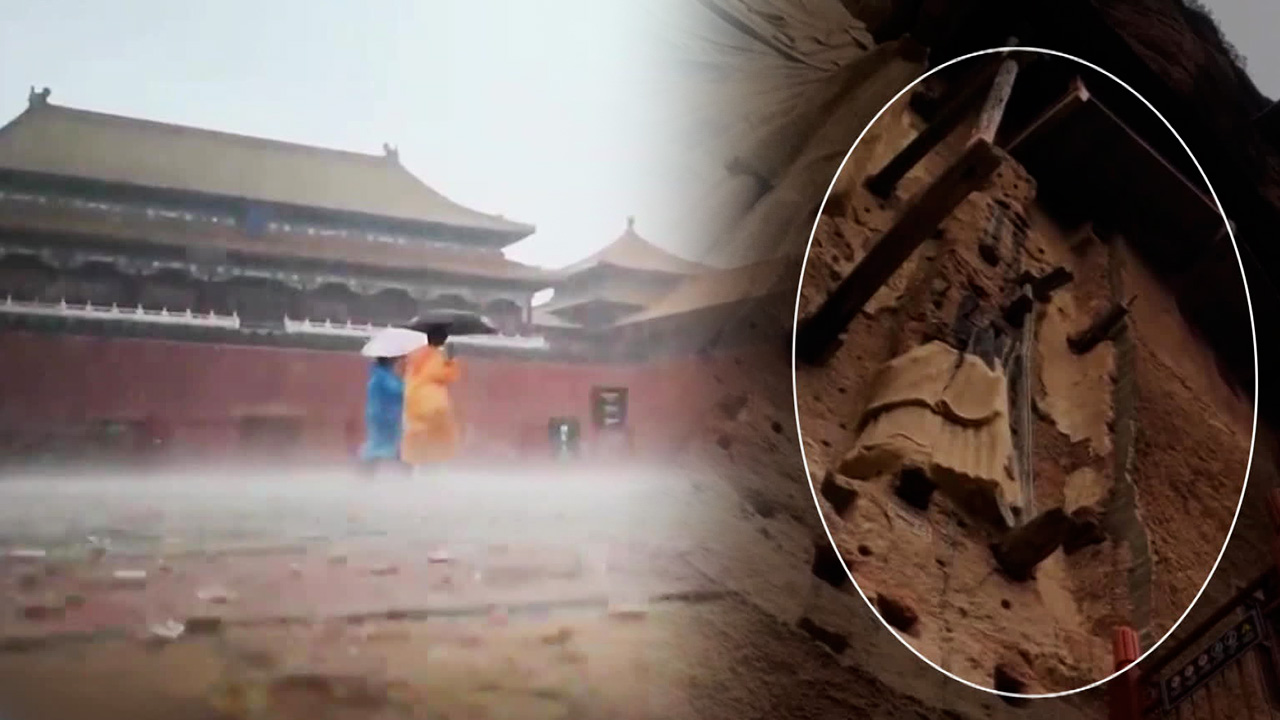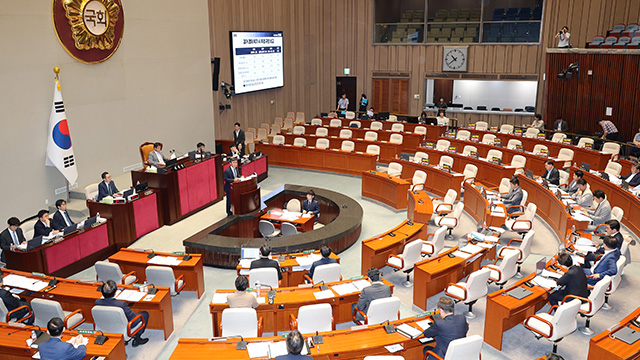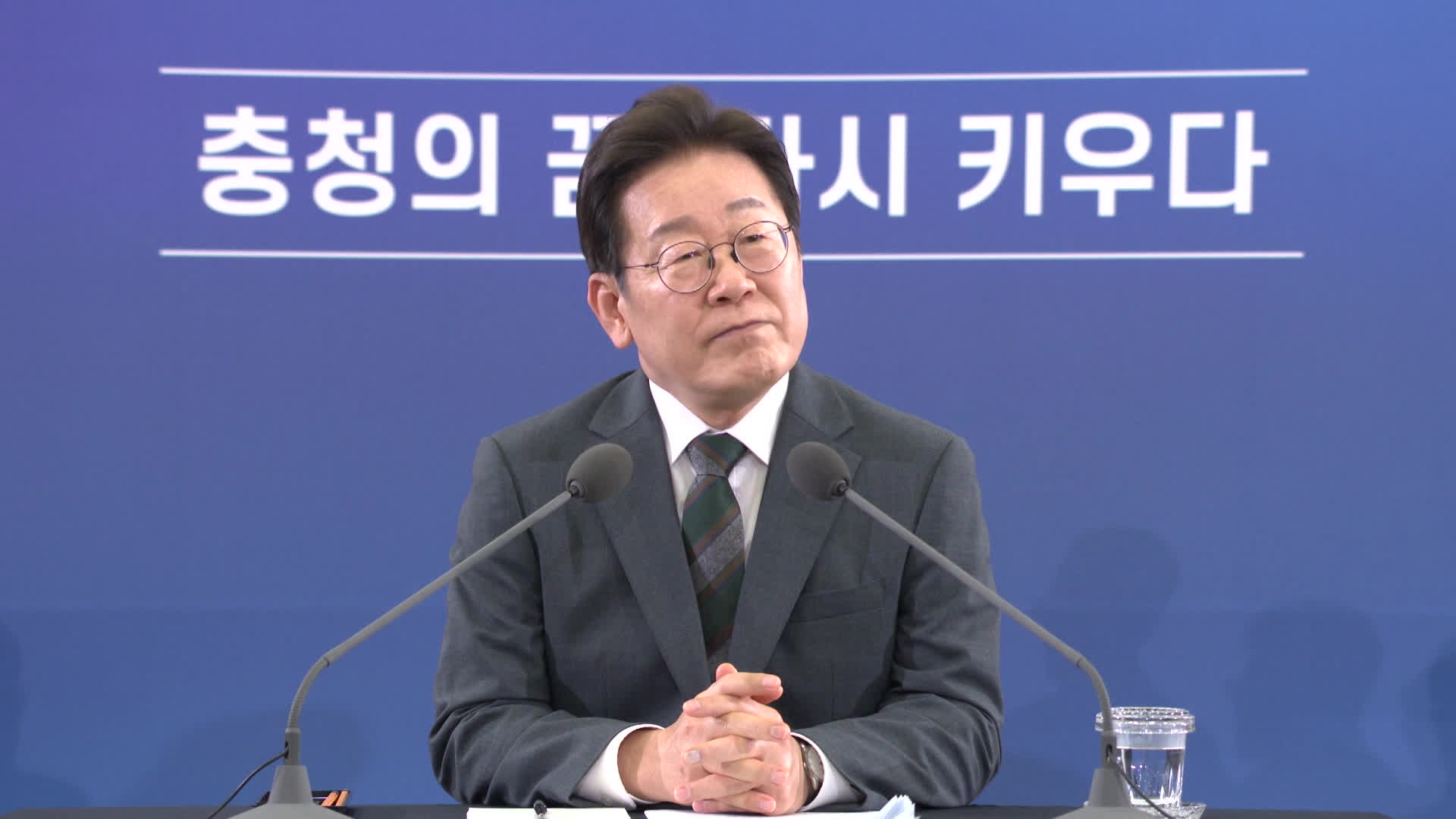Heavy rain in deserts of China threaten preservation of historical UNESCO World Heritage sites
입력 2024.10.27 (01:46)
읽어주기 기능은 크롬기반의
브라우저에서만 사용하실 수 있습니다.
[Anchor]
Extreme weather conditions in China is also affecting its cultural heritage.
Due to heavy rainfall, cave paintings in the desert are melting away, and the Forbidden City has been flooded for the first time in 600 years.
Reporter Kim Hyo-shin has covered the situation on-site.
[Report]
Dunhuang, once a frontier garrison on the Silk Road connecting China, West Asia, and Europe.
In this desert area, there are over 700 caves that have been used as prayer sites for Buddhist believers since 1,500 years ago.
Painted on clay plastered walls, murals cover an area of over 45,000 square meters, and many scriptures, including the "Wang O Cheon Chuk Guk Jeon," have been discovered, leading to its designation as a UNESCO World Heritage site.
However, recently, the murals and caves are being damaged at a rate faster than natural weathering.
Environmental organization Greenpeace has warned that some artifacts could be completely lost within a few years if the situation worsens.
The dry climate had solidified the murals, but in the past decade, increased rainfall has raised humidity, causing the clay walls to melt and collapse.
[Zhang Xiaogang/Deputy Chief of Dunhuang Caves Monitoring Center: "Generally, heavy rainfall can reach up to 50mm. However, even just 10mm of rain in our Mogao Caves can be dangerous."]
Even the Forbidden City in Beijing, a UNESCO World Heritage site, which had not accumulated water for 600 years, was flooded last year due to heavy rainfall.
Chinese cultural heritage authorities have stated that 90% of the damaged cultural sites were caused by natural disasters such as heavy rain, typhoons, and floods.
The Chinese authorities are striving to come up with countermeasures, including the introduction of a system to monitor the humidity and temperature of cultural heritage sites in real-time.
This is Kim Hyo-shin from KBS News in Dunhuang, China.
Extreme weather conditions in China is also affecting its cultural heritage.
Due to heavy rainfall, cave paintings in the desert are melting away, and the Forbidden City has been flooded for the first time in 600 years.
Reporter Kim Hyo-shin has covered the situation on-site.
[Report]
Dunhuang, once a frontier garrison on the Silk Road connecting China, West Asia, and Europe.
In this desert area, there are over 700 caves that have been used as prayer sites for Buddhist believers since 1,500 years ago.
Painted on clay plastered walls, murals cover an area of over 45,000 square meters, and many scriptures, including the "Wang O Cheon Chuk Guk Jeon," have been discovered, leading to its designation as a UNESCO World Heritage site.
However, recently, the murals and caves are being damaged at a rate faster than natural weathering.
Environmental organization Greenpeace has warned that some artifacts could be completely lost within a few years if the situation worsens.
The dry climate had solidified the murals, but in the past decade, increased rainfall has raised humidity, causing the clay walls to melt and collapse.
[Zhang Xiaogang/Deputy Chief of Dunhuang Caves Monitoring Center: "Generally, heavy rainfall can reach up to 50mm. However, even just 10mm of rain in our Mogao Caves can be dangerous."]
Even the Forbidden City in Beijing, a UNESCO World Heritage site, which had not accumulated water for 600 years, was flooded last year due to heavy rainfall.
Chinese cultural heritage authorities have stated that 90% of the damaged cultural sites were caused by natural disasters such as heavy rain, typhoons, and floods.
The Chinese authorities are striving to come up with countermeasures, including the introduction of a system to monitor the humidity and temperature of cultural heritage sites in real-time.
This is Kim Hyo-shin from KBS News in Dunhuang, China.
■ 제보하기
▷ 카카오톡 : 'KBS제보' 검색, 채널 추가
▷ 전화 : 02-781-1234, 4444
▷ 이메일 : kbs1234@kbs.co.kr
▷ 유튜브, 네이버, 카카오에서도 KBS뉴스를 구독해주세요!
- Heavy rain in deserts of China threaten preservation of historical UNESCO World Heritage sites
-
- 입력 2024-10-27 01:46:03

[Anchor]
Extreme weather conditions in China is also affecting its cultural heritage.
Due to heavy rainfall, cave paintings in the desert are melting away, and the Forbidden City has been flooded for the first time in 600 years.
Reporter Kim Hyo-shin has covered the situation on-site.
[Report]
Dunhuang, once a frontier garrison on the Silk Road connecting China, West Asia, and Europe.
In this desert area, there are over 700 caves that have been used as prayer sites for Buddhist believers since 1,500 years ago.
Painted on clay plastered walls, murals cover an area of over 45,000 square meters, and many scriptures, including the "Wang O Cheon Chuk Guk Jeon," have been discovered, leading to its designation as a UNESCO World Heritage site.
However, recently, the murals and caves are being damaged at a rate faster than natural weathering.
Environmental organization Greenpeace has warned that some artifacts could be completely lost within a few years if the situation worsens.
The dry climate had solidified the murals, but in the past decade, increased rainfall has raised humidity, causing the clay walls to melt and collapse.
[Zhang Xiaogang/Deputy Chief of Dunhuang Caves Monitoring Center: "Generally, heavy rainfall can reach up to 50mm. However, even just 10mm of rain in our Mogao Caves can be dangerous."]
Even the Forbidden City in Beijing, a UNESCO World Heritage site, which had not accumulated water for 600 years, was flooded last year due to heavy rainfall.
Chinese cultural heritage authorities have stated that 90% of the damaged cultural sites were caused by natural disasters such as heavy rain, typhoons, and floods.
The Chinese authorities are striving to come up with countermeasures, including the introduction of a system to monitor the humidity and temperature of cultural heritage sites in real-time.
This is Kim Hyo-shin from KBS News in Dunhuang, China.
Extreme weather conditions in China is also affecting its cultural heritage.
Due to heavy rainfall, cave paintings in the desert are melting away, and the Forbidden City has been flooded for the first time in 600 years.
Reporter Kim Hyo-shin has covered the situation on-site.
[Report]
Dunhuang, once a frontier garrison on the Silk Road connecting China, West Asia, and Europe.
In this desert area, there are over 700 caves that have been used as prayer sites for Buddhist believers since 1,500 years ago.
Painted on clay plastered walls, murals cover an area of over 45,000 square meters, and many scriptures, including the "Wang O Cheon Chuk Guk Jeon," have been discovered, leading to its designation as a UNESCO World Heritage site.
However, recently, the murals and caves are being damaged at a rate faster than natural weathering.
Environmental organization Greenpeace has warned that some artifacts could be completely lost within a few years if the situation worsens.
The dry climate had solidified the murals, but in the past decade, increased rainfall has raised humidity, causing the clay walls to melt and collapse.
[Zhang Xiaogang/Deputy Chief of Dunhuang Caves Monitoring Center: "Generally, heavy rainfall can reach up to 50mm. However, even just 10mm of rain in our Mogao Caves can be dangerous."]
Even the Forbidden City in Beijing, a UNESCO World Heritage site, which had not accumulated water for 600 years, was flooded last year due to heavy rainfall.
Chinese cultural heritage authorities have stated that 90% of the damaged cultural sites were caused by natural disasters such as heavy rain, typhoons, and floods.
The Chinese authorities are striving to come up with countermeasures, including the introduction of a system to monitor the humidity and temperature of cultural heritage sites in real-time.
This is Kim Hyo-shin from KBS News in Dunhuang, China.
-
-

김효신 기자 shiny33@kbs.co.kr
김효신 기자의 기사 모음
-
이 기사가 좋으셨다면
-
좋아요
0
-
응원해요
0
-
후속 원해요
0













![[단독] “이 대통령, 주요국에 특사파견 예정…미·일 특사 막판 조율”](/data/layer/904/2025/07/20250704_DNItCk.jpg)

이 기사에 대한 의견을 남겨주세요.